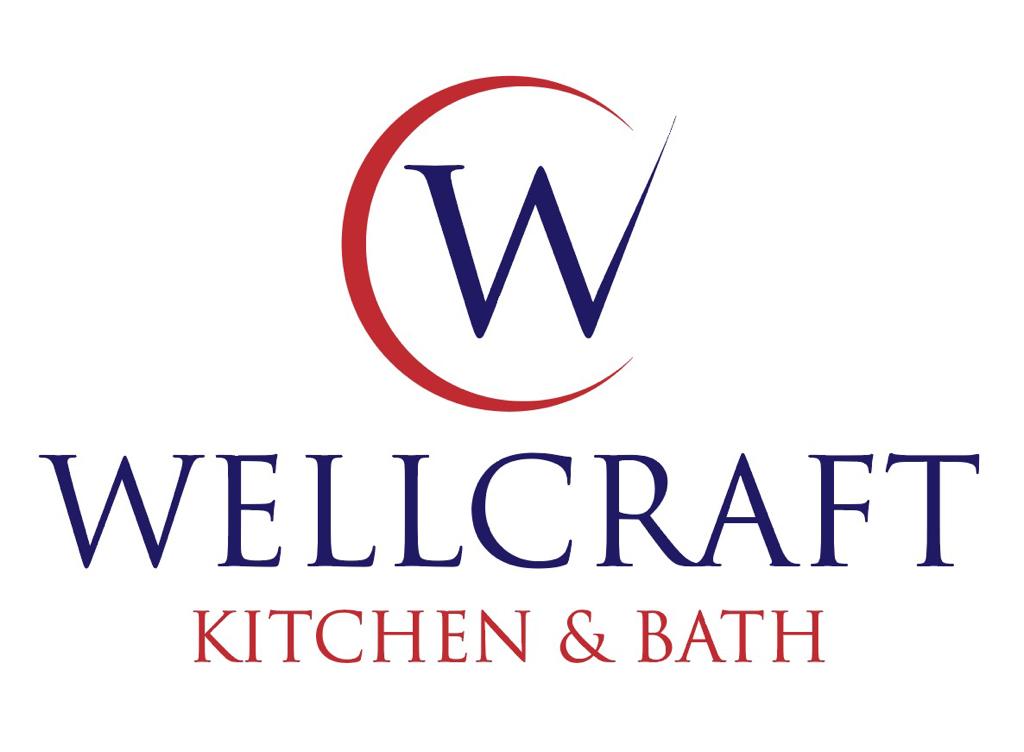Contents
- 1 Introduction
- 2 1. Luxury Vinyl Plank: The Best Kitchen Flooring for Performance and Style
- 3 2. Engineered Hardwood: Premium Best Kitchen Flooring with Natural Beauty
- 4 3. Porcelain Tile: The Best Kitchen Flooring for Durability and Design
- 5 4. Natural Stone: Luxury Best Kitchen Flooring with Timeless Appeal
- 6 5. Sustainable Options: Eco-Friendly Best Kitchen Flooring Choices
- 7 6. Mixed Material Installations: Creative Best Kitchen Flooring Solutions
- 8 7. Smart Flooring Technology: Future-Forward Best Kitchen Flooring
- 9 8. Installation and Maintenance: Maximizing Best Kitchen Flooring Performance
- 10 Conclusion
- 10.1 What is considered the best kitchen flooring material for busy families with children and pets?
- 10.2 How do I determine the best kitchen flooring for my specific budget and design preferences?
- 10.3 What makes certain flooring materials better than others for kitchen applications specifically?
- 10.4 Should I choose the same flooring throughout an open-concept kitchen and living area, or use different materials?
- 10.5 How important is professional installation for achieving the best kitchen flooring performance?
- 11 Sources/References
Introduction
Finding the best kitchen flooring for your home in 2025 requires understanding current design trends, material innovations, and performance characteristics that define today’s most popular flooring solutions. The best kitchen flooring options seamlessly blend aesthetic appeal with practical functionality, addressing the unique demands of modern kitchen environments while reflecting contemporary design preferences.
Kitchen flooring trends for 2025 showcase remarkable advances in material technology, sustainability practices, and design versatility that expand options for homeowners seeking the best kitchen flooring solutions. These developments enable achievement of luxury aesthetics without compromising durability, maintenance requirements, or environmental responsibility that characterize the best kitchen flooring choices.
The modern kitchen serves multiple functions beyond food preparation, demanding the best kitchen flooring options that accommodate entertaining, casual dining, homework sessions, and family gatherings while maintaining beauty and performance over years of intensive use. Today’s best kitchen flooring materials excel in moisture resistance, stain protection, and easy maintenance essential for busy households.
Technological innovations have revolutionized what constitutes the best kitchen flooring, with advanced manufacturing processes creating materials that offer unprecedented combinations of beauty, durability, and sustainability. These innovations enable homeowners to achieve their design vision while ensuring their flooring choice represents the best kitchen flooring investment for long-term satisfaction.
Market research consistently shows that kitchen renovations provide excellent return on investment, with flooring selections significantly influencing both immediate satisfaction and property values. Understanding what makes the best kitchen flooring helps homeowners make informed decisions that align with current trends while ensuring lasting appeal and performance.
This comprehensive guide explores the most significant trends defining the best kitchen flooring options for 2025, examining materials, design approaches, installation considerations, and practical factors that influence successful flooring selections for contemporary kitchen spaces.
1. Luxury Vinyl Plank: The Best Kitchen Flooring for Performance and Style

Luxury vinyl plank (LVP) consistently ranks among the best kitchen flooring options for 2025, combining realistic aesthetics with superior performance characteristics that address every practical concern while offering design flexibility that accommodates diverse style preferences and budget requirements.
Why LVP Represents the Best Kitchen Flooring Choice:
- 100% waterproof construction eliminating moisture damage concerns
- Superior scratch and stain resistance withstanding heavy kitchen use
- Realistic wood and stone appearances rivaling natural materials
- Easy installation reducing labor costs and renovation timelines
- Comfortable underfoot feel with sound-dampening properties
- Low maintenance requirements preserving busy household schedules
- Excellent value proposition balancing cost with performance
- Wide variety of styles accommodating all design preferences
The waterproof construction of modern LVP makes it arguably the best kitchen flooring for homes with active families, pets, or frequent entertaining where spills and moisture exposure are inevitable. Unlike traditional hardwood or laminate flooring, quality LVP can withstand standing water without damage, swelling, or delamination.
Advanced photographic technology in premium LVP products creates incredibly realistic reproductions of natural wood grain, stone textures, and exotic materials that make it difficult to distinguish from natural materials at normal viewing distances. This realism allows homeowners to achieve luxury aesthetics while maintaining the practical benefits that make LVP the best kitchen flooring for many applications.
The rigid core technology in high-end LVP products provides dimensional stability and walking comfort that rivals traditional hardwood flooring while offering superior moisture resistance and easier maintenance. These cores often incorporate stone plastic composite (SPC) or wood plastic composite (WPC) materials that enhance stability and comfort.
Installation advantages make LVP attractive for both DIY enthusiasts and professional installations, with click-lock systems enabling floating installations over existing flooring in many cases. This installation flexibility reduces costs and timelines while making LVP accessible for various renovation scenarios.
The maintenance advantages of LVP contribute significantly to its status as the best kitchen flooring for busy households, requiring only regular sweeping and occasional damp mopping to maintain appearance and hygiene. The surface treatments resist staining and scratching while maintaining their appearance over years of use.
2. Engineered Hardwood: Premium Best Kitchen Flooring with Natural Beauty
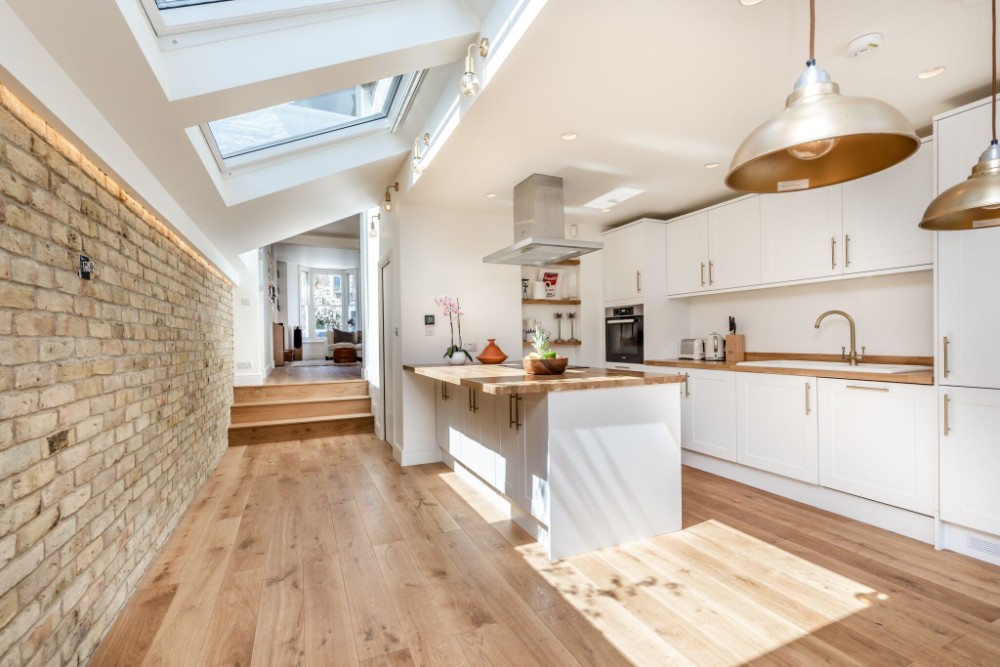
Engineered hardwood represents the best kitchen flooring choice for homeowners who prioritize natural wood beauty while requiring enhanced stability and moisture resistance that traditional solid hardwood cannot provide in kitchen environments with varying humidity and temperature conditions.
Engineered Hardwood as Best Kitchen Flooring:
- Natural wood beauty with enhanced dimensional stability
- Superior moisture resistance compared to solid hardwood
- Multiple refinishing opportunities extending lifespan
- Wide plank options creating luxurious, spacious appearances
- Variety of wood species accommodating diverse design preferences
- Professional installation ensuring optimal performance and warranty coverage
- Sustainable options including certified and reclaimed materials
- Excellent resale value contribution enhancing property values
The layered construction of engineered hardwood provides the authentic appearance and feel of solid hardwood while offering superior dimensional stability that makes it suitable for kitchen applications. The cross-grain construction minimizes expansion and contraction that can cause problems with solid hardwood in areas with moisture and temperature fluctuations.
Modern engineered hardwood products feature thick wear layers that can be refinished multiple times, providing longevity that justifies the investment and makes engineered hardwood competitive with solid hardwood for long-term value. Quality products offer wear layers of 3-6mm that support professional refinishing when needed.
The variety of wood species available in engineered formats enables homeowners to achieve specific aesthetic goals while maintaining the performance benefits that make engineered hardwood the best kitchen flooring choice for many applications. Popular species include oak, maple, hickory, and exotic options like Brazilian cherry and acacia.
Wide plank engineered hardwood creates dramatic visual impact while showcasing wood grain patterns more effectively than narrow planks. These wider planks, typically ranging from 5-12 inches, create more luxurious appearances while reducing the number of seams and creating cleaner, more contemporary looks.
The sustainability profile of engineered hardwood often exceeds solid hardwood due to efficient use of wood resources, with the core layers utilizing fast-growing species while reserving premium hardwoods for the visible wear layer. Many manufacturers offer certified sustainable options that support responsible forestry practices.
3. Porcelain Tile: The Best Kitchen Flooring for Durability and Design
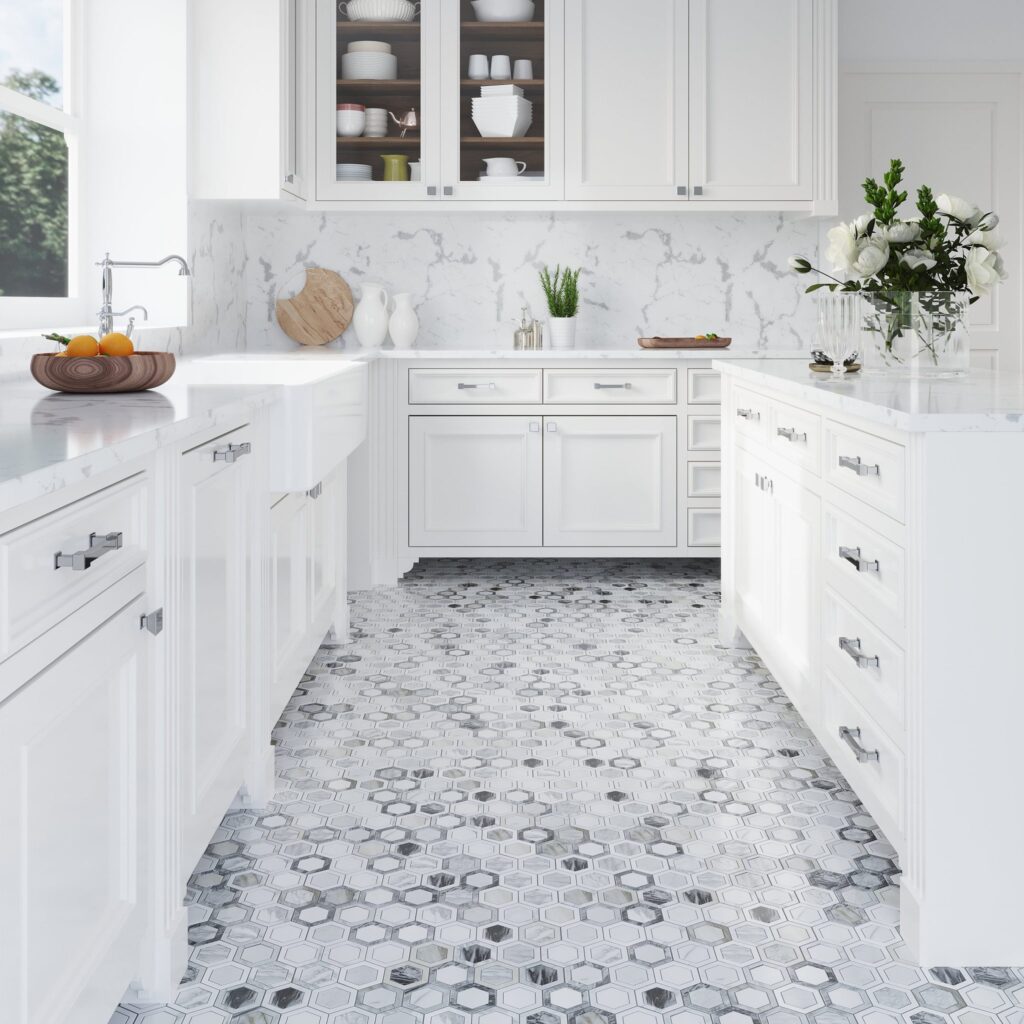
Large format porcelain tile has emerged as the best kitchen flooring option for homeowners seeking maximum durability, design flexibility, and low maintenance requirements while achieving stunning visual effects that rival natural stone and hardwood materials.
Porcelain Tile Best Kitchen Flooring Advantages:
- Exceptional durability withstanding heavy traffic and impact
- Complete moisture resistance preventing damage from spills and humidity
- Stain resistance maintaining appearance with minimal maintenance
- Design versatility including realistic wood and stone appearances
- Large format options reducing grout lines and maintenance requirements
- Heat resistance accommodating radiant heating systems
- Hygienic surface properties supporting food safety requirements
- Long-term value through durability and timeless appeal
The exceptional durability of porcelain tile makes it the best kitchen flooring choice for households with heavy traffic, large families, or frequent entertaining where flooring must withstand intensive use without showing wear or damage. The fired clay construction creates a surface harder than natural stone while maintaining consistent appearance over decades.
Modern digital printing technology enables porcelain manufacturers to create incredibly realistic reproductions of natural materials including hardwood, natural stone, fabric, and metal surfaces. These advanced printing techniques capture subtle variations and authentic textures that were previously impossible to achieve in ceramic materials.
Large format porcelain tiles, often measuring 24×48 inches or larger, create dramatic visual impact while minimizing grout lines that require maintenance. These large formats work particularly well in contemporary kitchen designs where clean, uninterrupted surfaces enhance modern aesthetics while reducing cleaning requirements.
The complete moisture resistance of porcelain tile eliminates concerns about water damage, making it ideal for kitchen applications where spills, humidity, and cleaning activities create challenging conditions for other flooring materials. This moisture resistance extends to freeze-thaw resistance for kitchens with outdoor access.
Radiant heating compatibility makes porcelain tile an excellent choice for homeowners seeking heated floors, as the material’s thermal mass properties work efficiently with radiant systems while providing comfortable walking surfaces that address the traditional coldness associated with tile flooring.
4. Natural Stone: Luxury Best Kitchen Flooring with Timeless Appeal
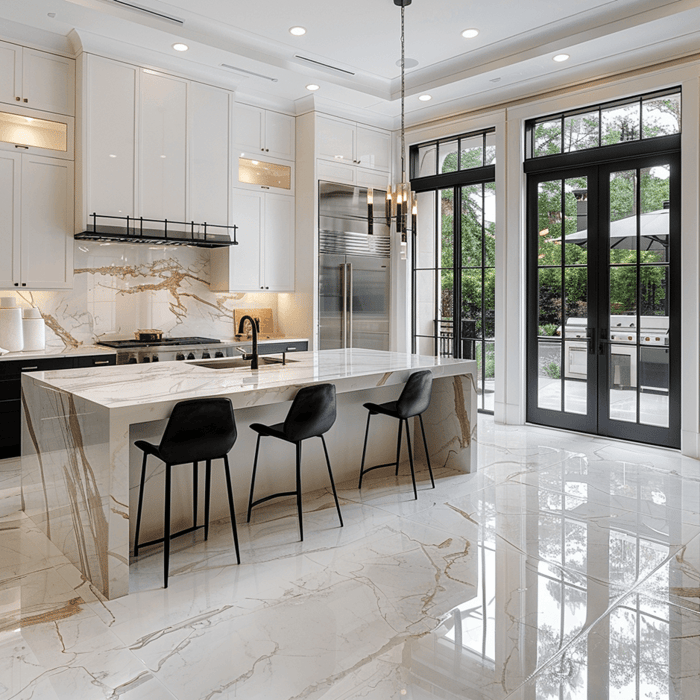
Natural stone flooring represents the best kitchen flooring choice for homeowners seeking luxury materials with timeless appeal, unique character, and the prestige associated with authentic natural materials that enhance property values while providing decades of beauty and performance.
Natural Stone Best Kitchen Flooring Benefits:
- Authentic natural beauty with unique character in every installation
- Exceptional durability providing decades of service with proper care
- Timeless appeal that transcends design trends and style changes
- Excellent thermal mass properties for radiant heating applications
- Unique patterns and variations creating one-of-a-kind installations
- Premium property value enhancement exceeding other flooring materials
- Sustainable material choice with minimal environmental processing
- Professional refinishing options restoring original beauty when needed
The authentic beauty of natural stone creates installations that are truly unique, with each piece displaying natural variations in color, pattern, and texture that cannot be replicated in manufactured materials. This uniqueness makes natural stone the best kitchen flooring choice for homeowners seeking distinctive, luxury installations.
Popular natural stone options for kitchen flooring include travertine, slate, limestone, and granite, each offering distinct aesthetic characteristics and performance properties. Travertine provides warm, earth-tone beauty with natural texture, while slate offers dramatic color variations and excellent durability.
The thermal mass properties of natural stone make it excellent for radiant heating applications, efficiently storing and releasing heat to create comfortable walking surfaces while potentially reducing overall heating costs. The stone’s ability to retain heat creates consistent temperatures that enhance comfort.
Proper sealing and maintenance preserve natural stone’s beauty and performance, with modern sealers providing enhanced stain and moisture resistance while maintaining the stone’s natural appearance. Professional maintenance services can restore damaged stone surfaces to original condition through grinding and polishing.
The investment value of natural stone flooring often justifies the higher initial cost through enhanced property values, with luxury stone installations significantly contributing to home values and market appeal. Quality stone installations can last for decades with proper care, providing excellent long-term value.
5. Sustainable Options: Eco-Friendly Best Kitchen Flooring Choices
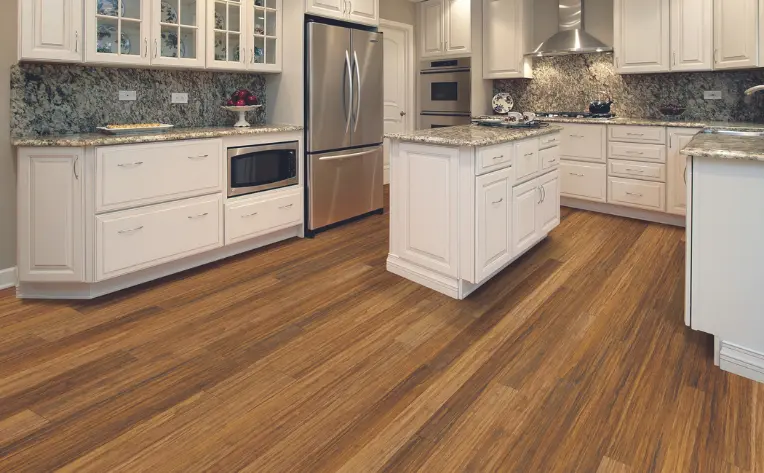
Sustainable flooring materials represent the best kitchen flooring options for environmentally conscious homeowners seeking to reduce their ecological footprint while maintaining high standards for aesthetics, performance, and durability that characterize quality flooring investments.
Sustainable Best Kitchen Flooring Materials:
- Bamboo flooring offering rapid renewability and natural beauty
- Cork flooring providing comfort, insulation, and antimicrobial properties
- Reclaimed wood creating unique character while supporting sustainability
- Recycled content products diverting waste from landfills
- Bio-based materials utilizing agricultural waste and renewable resources
- Low-VOC products improving indoor air quality and health
- Locally sourced materials reducing transportation environmental impact
- End-of-life recyclability supporting circular economy principles
Bamboo flooring has gained recognition as the best kitchen flooring choice for sustainability-focused homeowners, with bamboo’s rapid growth rate making it highly renewable while modern manufacturing creates products with excellent durability and moisture resistance suitable for kitchen applications.
Cork flooring offers unique benefits including natural antimicrobial properties, excellent insulation characteristics, and comfortable walking surfaces that reduce fatigue during extended kitchen activities. The harvesting process preserves cork oak trees, which continue producing bark for decades without harm.
Reclaimed wood flooring provides unmatched character and sustainability by repurposing materials from old buildings, barns, and industrial structures. Each reclaimed installation tells a unique story while preventing valuable timber from entering landfills and reducing demand for newly harvested materials.
The focus on indoor air quality has driven development of low-VOC and formaldehyde-free flooring products that contribute to healthier indoor environments. These considerations are particularly important in kitchens where food preparation occurs and families spend significant time together.
Recycled content flooring products utilize post-consumer and post-industrial waste streams to create attractive and durable options that support circular economy principles while often achieving superior performance characteristics compared to traditional materials.
6. Mixed Material Installations: Creative Best Kitchen Flooring Solutions
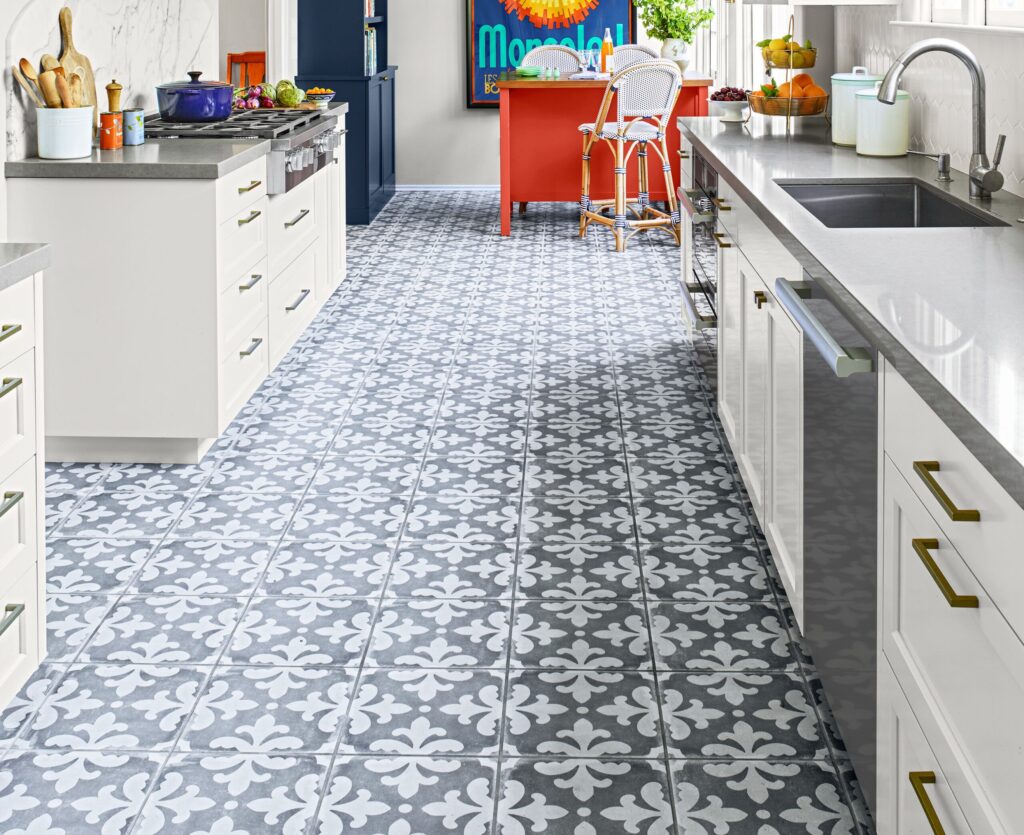
Mixed material flooring installations represent innovative approaches to achieving the best kitchen flooring solutions by combining different materials to optimize performance, create visual interest, and establish functional zones within open-concept kitchen and living spaces.
Mixed Material Best Kitchen Flooring Strategies:
- Kitchen island differentiation creating focal points and functional zones
- Transition solutions enabling seamless material changes
- Complementary material palettes ensuring visual harmony
- Functional zoning optimizing performance for specific areas
- Custom design solutions reflecting individual style preferences
- Professional installation ensuring durable and attractive transitions
- Color coordination maintaining design continuity across materials
- Budget optimization using premium materials strategically
Kitchen island differentiation through unique flooring materials creates visual focal points while potentially providing enhanced performance characteristics for high-use areas. Popular approaches include using stone or tile around islands while maintaining wood or luxury vinyl in surrounding areas.
The development of advanced transition strip technologies enables seamless connections between different flooring materials, with options including flush mount transitions, decorative metal strips, and custom-fabricated solutions that maintain aesthetic appeal while providing durable connections.
Functional zoning through strategic material placement optimizes performance by using the most appropriate material for each area’s specific requirements. This approach allows homeowners to achieve the best kitchen flooring solution by matching materials to usage patterns and performance needs.
Professional installation becomes particularly important for mixed material installations, as proper execution requires expertise in multiple flooring types and transition techniques to achieve professional results that maintain durability and aesthetic appeal over time.
Budget optimization through mixed materials enables strategic use of premium materials in key areas while using more cost-effective options in lower-impact zones, creating overall installations that achieve luxury appearance while managing costs effectively.
7. Smart Flooring Technology: Future-Forward Best Kitchen Flooring

Smart flooring technology represents the cutting edge of the best kitchen flooring options for 2025, with innovative systems incorporating sensors, heating elements, and connectivity features that enhance functionality while integrating with broader smart home ecosystems.
Smart Best Kitchen Flooring Features:
- Integrated radiant heating with smart controls and scheduling
- Pressure-sensitive sensors for safety monitoring and automation
- LED lighting integration providing accent and safety lighting
- Wireless charging zones embedded within flooring surfaces
- Air quality monitoring supporting healthier indoor environments
- Moisture detection systems providing leak alerts and prevention
- Energy harvesting technology generating power from foot traffic
- Voice control integration enabling hands-free operation
Radiant heating systems integrated with smart controls provide the best kitchen flooring solution for comfort while potentially reducing overall heating costs through zoned heating and intelligent scheduling. These systems can be controlled remotely and programmed for optimal efficiency.
Pressure-sensitive sensor technology embedded in flooring provides valuable safety and monitoring capabilities, particularly beneficial for elderly residents or households with young children. These sensors can detect falls, monitor activity patterns, and provide alerts when appropriate.
LED lighting integration creates the best kitchen flooring solution for ambiance while providing practical benefits including pathway lighting during nighttime visits and accent lighting that enhances overall kitchen atmosphere. These systems can respond to motion, time, or manual control.
Wireless charging zones embedded within flooring surfaces provide convenient device charging without visible charging stations, maintaining clean kitchen aesthetics while providing practical functionality for devices commonly used in kitchen environments.
Air quality monitoring capabilities integrated into smart flooring systems can track indoor parameters including humidity, temperature, and pollutant levels, providing data that supports healthier indoor environments and can trigger ventilation systems when needed.
8. Installation and Maintenance: Maximizing Best Kitchen Flooring Performance
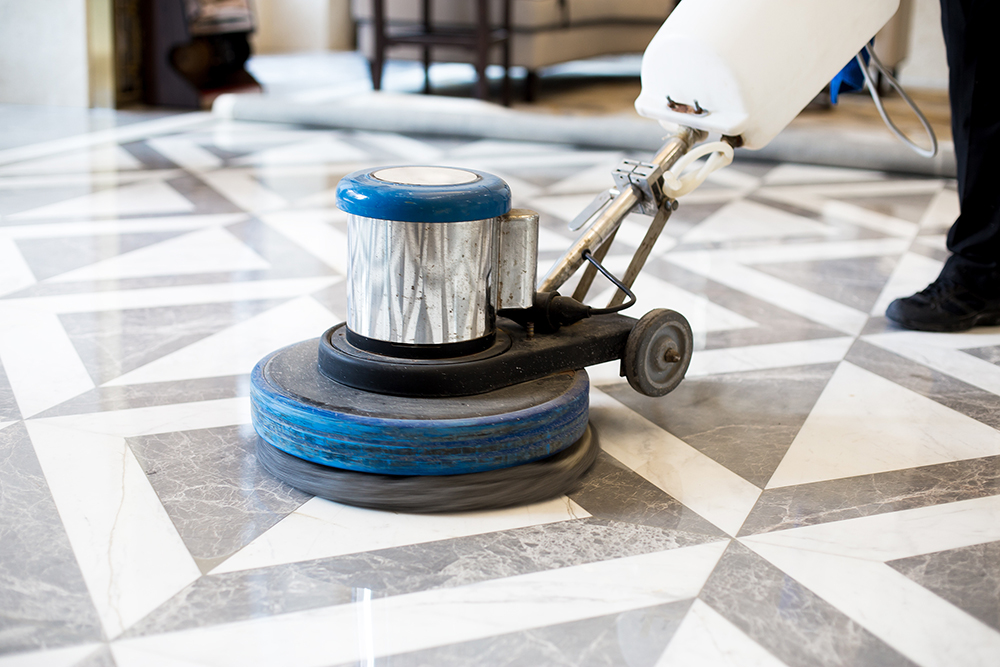
Proper installation and maintenance practices are essential for achieving optimal performance from the best kitchen flooring materials, with professional installation and appropriate care protocols ensuring maximum lifespan, appearance retention, and warranty protection for flooring investments.
Best Kitchen Flooring Installation Practices:
- Professional assessment of subfloor conditions and preparation requirements
- Proper moisture testing and vapor barrier installation when needed
- Accurate measurements and templating ensuring optimal material utilization
- Quality underlayment selection enhancing comfort and performance
- Expansion gap provisions accommodating seasonal movement
- Professional tool usage ensuring precise cuts and proper installation
- Manufacturer specification compliance maintaining warranty coverage
- Post-installation inspection and customer education for optimal care
Professional subfloor assessment ensures that the best kitchen flooring installation starts with proper foundation preparation, addressing any moisture issues, levelness concerns, or structural problems that could affect flooring performance or warranty coverage.
Moisture testing becomes particularly important for the best kitchen flooring installations, as even materials marketed as waterproof can experience problems if excessive moisture exists in the subfloor or surrounding areas. Proper vapor barriers and moisture mitigation ensure optimal performance.
Quality underlayment selection enhances the performance of many best kitchen flooring materials, providing sound dampening, thermal insulation, and walking comfort while potentially extending flooring lifespan through impact absorption and moisture protection.
Best Kitchen Flooring Maintenance Protocols:
- Regular cleaning schedules maintaining appearance and hygiene
- Appropriate cleaning products preserving finish integrity
- Prompt spill cleanup preventing staining and damage
- Periodic professional maintenance extending lifespan
- Furniture protection preventing scratches and indentations
- Climate control maintaining optimal environmental conditions
- Manufacturer warranty compliance ensuring coverage protection
- Professional refinishing when appropriate restoring original beauty
Regular cleaning with appropriate products maintains the appearance and performance of the best kitchen flooring materials while preventing buildup that could cause permanent damage or void warranty coverage. Different materials require specific cleaning approaches for optimal results.
Prompt spill cleanup remains important even for the most stain-resistant best kitchen flooring materials, as prolonged exposure to certain substances can cause problems even with highly resistant surfaces. Immediate attention prevents most potential issues.
Professional maintenance services provide valuable support for maintaining the best kitchen flooring installations, with periodic deep cleaning, resealing when appropriate, and professional assessment helping to identify and address issues before they become serious problems.
Conclusion
Selecting the best kitchen flooring for 2025 requires balancing aesthetic preferences, performance requirements, budget considerations, and lifestyle factors that vary among homeowners and applications. The best kitchen flooring choice ultimately depends on individual priorities and specific usage requirements.
Luxury vinyl plank continues to represent the best kitchen flooring option for many homeowners due to its combination of realistic aesthetics, superior performance, waterproof construction, and practical advantages including easy installation and low maintenance requirements.
Engineered hardwood provides the best kitchen flooring solution for homeowners who prioritize natural wood beauty while requiring enhanced moisture resistance and dimensional stability that traditional solid hardwood cannot provide in kitchen environments.
Porcelain tile offers the best kitchen flooring choice for maximum durability, design flexibility, and low maintenance requirements, with large format options creating stunning visual effects while providing practical benefits including stain resistance and easy cleaning.
Natural stone represents the best kitchen flooring option for luxury applications where authentic material beauty and unique character justify higher costs and maintenance requirements, providing timeless appeal and excellent property value enhancement.
Sustainable options including bamboo, cork, and reclaimed materials offer the best kitchen flooring choices for environmentally conscious homeowners seeking to reduce ecological impact while maintaining high standards for aesthetics and performance.
The future of the best kitchen flooring includes smart technology integration, mixed material installations, and continued innovation in sustainable materials that expand options while improving performance characteristics and environmental responsibility.
How do I determine the best kitchen flooring for my specific budget and design preferences?
Determining the best kitchen flooring requires evaluating your budget range, design goals, and performance priorities to find the optimal balance. Start by establishing your total budget including materials, installation, and any necessary subfloor preparation. Luxury vinyl plank offers the best value for most budgets, providing premium appearance at moderate cost. Engineered hardwood provides natural beauty at mid-range pricing, while porcelain tile offers excellent durability across various price points. Natural stone represents the premium option with highest costs but maximum luxury appeal. Consider long-term costs including maintenance and potential refinishing when comparing options, as some materials with higher upfront costs may provide better long-term value.
What makes certain flooring materials better than others for kitchen applications specifically?
The best kitchen flooring materials excel in moisture resistance, stain protection, durability, and easy maintenance essential for kitchen environments. Kitchens experience frequent spills, temperature fluctuations, heavy foot traffic, and potential impacts from dropped objects that require flooring materials with superior performance characteristics. Waterproof construction prevents damage from spills and humidity, while stain resistance maintains appearance despite exposure to food, beverages, and cooking oils. Easy cleaning requirements support food safety and hygiene, while durability ensures long-term performance despite intensive use. The best kitchen flooring also provides comfort underfoot for extended standing during food preparation and cooking activities.
Should I choose the same flooring throughout an open-concept kitchen and living area, or use different materials?
The choice between consistent flooring or mixed materials in open-concept spaces depends on your design goals and functional requirements. Using the same flooring throughout creates visual continuity and makes spaces appear larger while simplifying maintenance and potentially reducing costs. However, mixed materials can define functional zones, optimize performance for specific areas, and create visual interest. Many homeowners choose the best kitchen flooring for high-use cooking areas while using complementary materials in dining and living zones. Professional design consultation can help determine the best approach for your specific layout, with proper transition strips ensuring seamless connections between different materials when mixed installations are chosen.
How important is professional installation for achieving the best kitchen flooring performance?
Professional installation is crucial for maximizing the performance and lifespan of the best kitchen flooring materials, particularly for premium options like hardwood, stone, and large format tiles. Professional installers ensure proper subfloor preparation, accurate measurements, appropriate expansion gaps, and manufacturer specification compliance that maintains warranty coverage. They have specialized tools and expertise to handle complex cuts around cabinets and appliances while achieving professional-quality results. While some materials like luxury vinyl plank can be DIY-friendly, professional installation typically provides better results, faster completion, and warranty protection that justifies the additional cost. Poor installation can void warranties and lead to premature failure even with the highest quality materials.
Sources/References
- National Wood Flooring Association – Installation and Maintenance Guidelines https://www.nwfa.org/
- Tile Council of North America – Technical Standards and Best Practices https://www.tcnatile.com/
- Resilient Floor Covering Institute – LVP Performance Standards https://rfci.com/
- National Kitchen and Bath Association – Flooring Selection Guidelines https://nkba.org/
- Environmental Protection Agency – Indoor Air Quality and Flooring https://www.epa.gov/indoor-air-quality-iaq
- Forest Stewardship Council – Sustainable Flooring Certification https://www.fsc.org/
- American Society for Testing and Materials – Flooring Performance Standards https://www.astm.org/
- Green Building Council – Sustainable Material Selection Guidelines https://www.usgbc.org/
